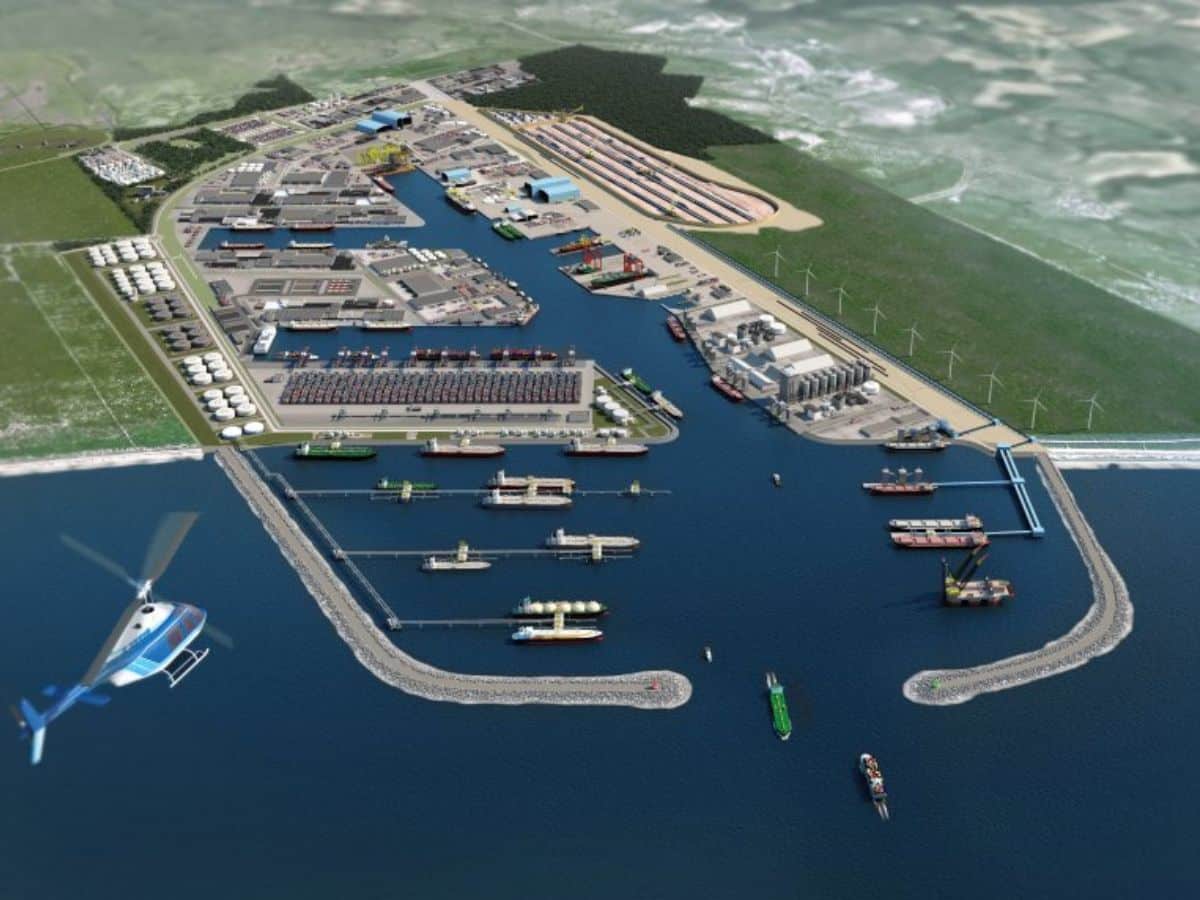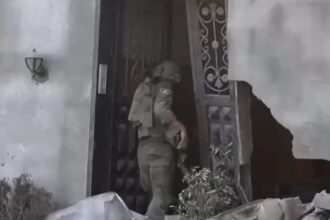By late 2024, dredgers began carving through the seabed off the coast of Presidente Kennedy, a small town in southern Espírito Santo, once known for its quiet beaches. This is the chosen site of Porto Central, Brazil’s next mega-port and one of the most ambitious private logistics projects in the country’s history.
Promoters describe Porto Central as “one of the largest industrial port complexes in Latin America”, a project meant to redefine Brazil’s export future. Yet, behind the promises of jobs and progress, tension is growing along this quiet stretch of coast. Critics are questioning who truly benefits from this ambitious initiative and who bears the hidden costs.
Porto Central spans 2,000 hectares, an area roughly the size of 2,800 football pitches, with a 25-metre-deep access channel capable of hosting giant VLCC (Very Large Crude Carrier) vessels. A single VLCC can carry approximately two million barrels of crude oil.
The project would host up to 54 terminals serving oil and gas, agribusiness, minerals, containers, and even renewable energy. Construction is divided into five phases, with total investment estimated around R$16bn (approximately $2.9bn).
Porto Central — A city by the sea
Porto Central’s attraction is geography. Sitting halfway along Brazil’s coastline, it promises to reduce transshipment and shorten export routes for oil and gas, grains, and iron ore.
Several major backers, including TPK Logística S.A., the Dutch company Van Oord, and the European subsidiary of US-based company Modern American Recycling Services (M.A.R.S.), are supporting Porto Central’s vast project, a deepwater hub designed to link Brazil’s pre-salt oil fields, agribusiness, and mining industries directly to global trade routes.
The pitch is clear and simple: reduce transshipment costs, shorten export routes, and compete with maritime giants like Rotterdam, Singapore, and Shanghai.
Phase 1 involves four core components: dredging 60 million m3 of seabed (the equivalent of 25,000 Olympic swimming pools); constructing a south breakwater with rock quarried 26 km inland; building a deep-water bulk and liquids terminal for oil transshipment; and developing a 65-hectare back area to assemble pipelines and foundations. Implementation began in late 2024, with full operational capacity planned for the end of the decade.
Yet, beneath the display of engineering confidence, lies a tangled web of risks.
Dredging up damage
The socio-environmental stakes are immense. Porto Central’s environmental impact report (RIMA) outlines a list of risks rarely seen in such concentration: seabed dredging that could raise turbidity suffocating coral and fish, altering sediment flow, accelerating coastal erosion.
Protected species, including sea turtles, dolphins, and even migrating whales, use this stretch of coast to feed and breed. Noise, ship traffic, and artificial light threaten those rhythms.
Artisanal fishermen, farmers, and quilombola communities, many of whom operate within sight of the dredging site, risk losing both fishing grounds and income. Past compensation programmes for similar projects have proved inconsistent.
In 2023, Brazil’s environmental agency, Ibama, issued an installation license (LI) to Porto Central relating to Phase 1 of the project, requiring extra monitoring and mitigation. Environmentalists warn that enforcement capacity remains limited.
Voices
Local voices warn that the ecological and social costs of Porto Central could far outweigh its promises. Teacher, environmentalist and activist, José Roberto da Silva Vidal, who has been following the project’s impact in Presidente Kennedy, spoke with deep concern:
It’s heartbreaking to see what’s happening to our land and sea as Porto Central moves forward. The restinga forests are being cleared, rocks are blasted apart, and the water that sustains life here is under threat. Every new truck, every machine adds to the damage releasing more emissions into an already fragile atmosphere. Calling this progress ignores the truth we’re all facing — the planet is warning us, and yet we keep choosing to look away.
On the front line against the Porto Central project, the grassroots group REDI, gives voice to fishing families and riverside communities whose lives and traditions are at risk. FASE Espírito Santo stands with them, supporting local communities, defending their land and waters, and demanding accountability from those pushing destructive projects.
Marcos Pedlowski, a researcher and associate professor at the State University of Northern Rio de Janeiro (UENF), expresses deep concern about the potential impact of Porto Central on the small, fragile town of Presidente Kennedy. His worries are based in nearly two decades of research and firsthand experience living among those affected by the Açu Port, another large-scale project located less than 100 km from Porto Central:
Presidente Kennedy is a poor, quiet place, unprepared for a project of this size. When thousands of workers arrive, life here will change overnight, and not for the better. We’ll see more social tension, more prostitution, more alcohol and drugs. Violence will rise, and the community will be left to deal with the consequences.
He warns that these social risks are tied to deeper political realities:
We already live with corruption and heavy-handed policing in Espírito Santo. When you add a project like Porto Central to that mix, you’re setting the stage for even greater injustice.
For Pedlowski, what’s happening in Presidente Kennedy is part of a larger story, one he has seen unfold before along Brazil’s coast:
These are what I call sacrifice ports. The investors know the damage they’ll cause: the erosion, the pollution, the displacement of fishermen and quilombola families. But the profits speak louder. Behind all the promises, what’s really at play is the takeover of land and sea, with the state working hand in hand with corporate power.
A fossil fuel magnet
Some of Porto Central’s confirmed clients are hardly green. The company has signed contracts with Brazil’s state-owned oil and gas company, Petrobras (2021), Norwegian Equinor (2024), Chinese CNOOC (2024), and Spanish Repsol Sinopec (2025), to handle crude oil and derivatives.
José Maria Vieira de Novaes, Porto Central’s CEO, described oil as “one of the anchors of the project”, citing government forecasts of booming exports and limited existing infrastructure.
“The existing terminals can’t absorb what’s coming,” he told Folha Business in 2022.
While Brazil pledges to decarbonise, its newest mega-port is potentially built to accelerate fossil-fuel throughout.
Who profits?
At the heart of Porto Central is TPK Logística S.A., owned by the Polimix Organisation, a major Brazilian conglomerate in concrete, aggregates, and logistics. Polimix is controlled by Ronaldo Moreira Vieira, and José Maria Vieira de Novaes is one of TPK Logística’s partner.
According to the International Consortium of Investigative Journalists (ICIJ), Ronaldo Moreira Vieira is listed in the Panama Papers database. Being listed “active” in that database means the entity was operational at the time of the 2016 leak, evidence of involvement in offshore structuring. Though not proof of illegality, the revelation invites scrutiny over transparency and beneficial ownership.
A president with 13 companies
José Maria Vieira de Novaes, meanwhile, wears many hats. Corporate registries show his name linked to 13 companies, from Agropecuária Limão Ltda to Kennedy Energia Solar Ltda and Praia Kennedy Empreendimentos Ltda, collectively controlling over R$388m (approximately $72m) in share capital.
Several of these companies operate within the same region as the port. Some are active in real estate and energy, the very sectors poised to benefit from Porto Central’s rise. Such overlap could allow Novaes to benefit indirectly from Porto Central’s infrastructure expansion, a potential conflict of interest that blurs the line between public good and private gain.
Hazards and mitigation
Brazil’s environmental agency, Ibama, has already required Porto Central to conduct additional sediment and noise studies before advancing major phases of construction. While the company claims to operate under “international environmental standards”, local NGOs accuse it of pre-empting full approval.
The list of some of the potential hazards reads like an environmental check-list from hell: destruction of marine habitats from dredging, disturbance to turtle nesting and marine mammal migration, erosion of beaches from altered sediment flow, pollution from oil spills, waste and sewage, noise and vibration from heavy machinery disturbing wildlife and residents, salinisation of groundwater, introduction of invasive species via ballast water, accident and spills during ship-to-ship transfer, destruction of mangroves, long-term erosion along the Presidente Kennedy coastline.
Porto Central vs Açu Port: a tale of two mega ports
Both Porto Central and Açu Port, located less than 100 km apart along Brazil’s southeast coast, share grand visions, deepwater and export terminals, and industrial zones promising jobs and growth.
Açu, launched in 2013 in São João da Barra, in Rio de Janeiro state, has matured into a functioning port and energy hub. Yet, academic research reveal deep scars: displacement of fishing families, salinisation of water tables, and unfulfilled social compensation. Research papers describe community disruption and environmental degradation as long-term legacies of the project.
Carlos Freitas, an environmentalist with the NGO REDI, says the story repeating in Presidente Kennedy is painfully familiar. His group has been working with fishing families and the farmers in the MST (landless workers’ movement) settlements near Morro da Serrinha, where quarrying for Porto Central’s construction has already disrupted lives.
What happened at Açu Port is happening again here – the same promises, the same silence about the damage. They call it progress, but what we see is destruction disguised as development.
He explains that company meetings are called with only a few days’ notice, leaving little room for real participation. Meanwhile, explosions from the quarry scare off animals, cause livestock miscarriages, and shake the homes of farming families.
People are being misled with talk of jobs and growth, while explosions shake their land and animals flee. In the MST settlements, families are watching their crops and animals suffer. Porto Central isn’t bringing life to this region – it’s taking it away.
This illustrates a shared Brazilian dilemma, rapid industrialisation without governance or ecological safeguards.
Logistics
Beneath the promise of progress lies uncertainty. The project relies on unfinished national logistic links, including the EF-118 railway between the capital of Espírito Santo, Vitória, and Rio de Janeiro, EF-352 linking the states of Espírito Santo, Minas Gerais and Goiás, and highway upgrades on BR-101 and BR-262. Without them, Porto Central could become a bottleneck. The port’s promoters insist the state government’s commitment will guarantee completion, but Brazil’s infrastructure history is littered with stalled railways.
Add to that the climate challenge, as rising seas and stronger storms could test the port’s defences before it’s even operational.
Ambition and accountability
Porto Central sums up Brazil’s eternal paradox: vast potential, fragile governance.
It could, in theory, anchor Brazil’s future in global trade. Yet, without transparency, oversight, and rigorous socio-environmental stewardship, it risks becoming another cautionary tale, of profit for a few and pollution for many, a crossroads between development and destruction.
With ownership structures stretching into offshore secrecy jurisdictions, and leadership linked to a constellation of private companies, accountability remains elusive.
Whether Porto Central becomes Brazil’s Rotterdam, or its next development scandal, will depend less on engineering than on ethics.
For many locals, the question isn’t whether Porto Central will rise, but who it’ll serve once it does.
Porto Central did not respond to a request for comment.
Featured image via PortoCentral website













